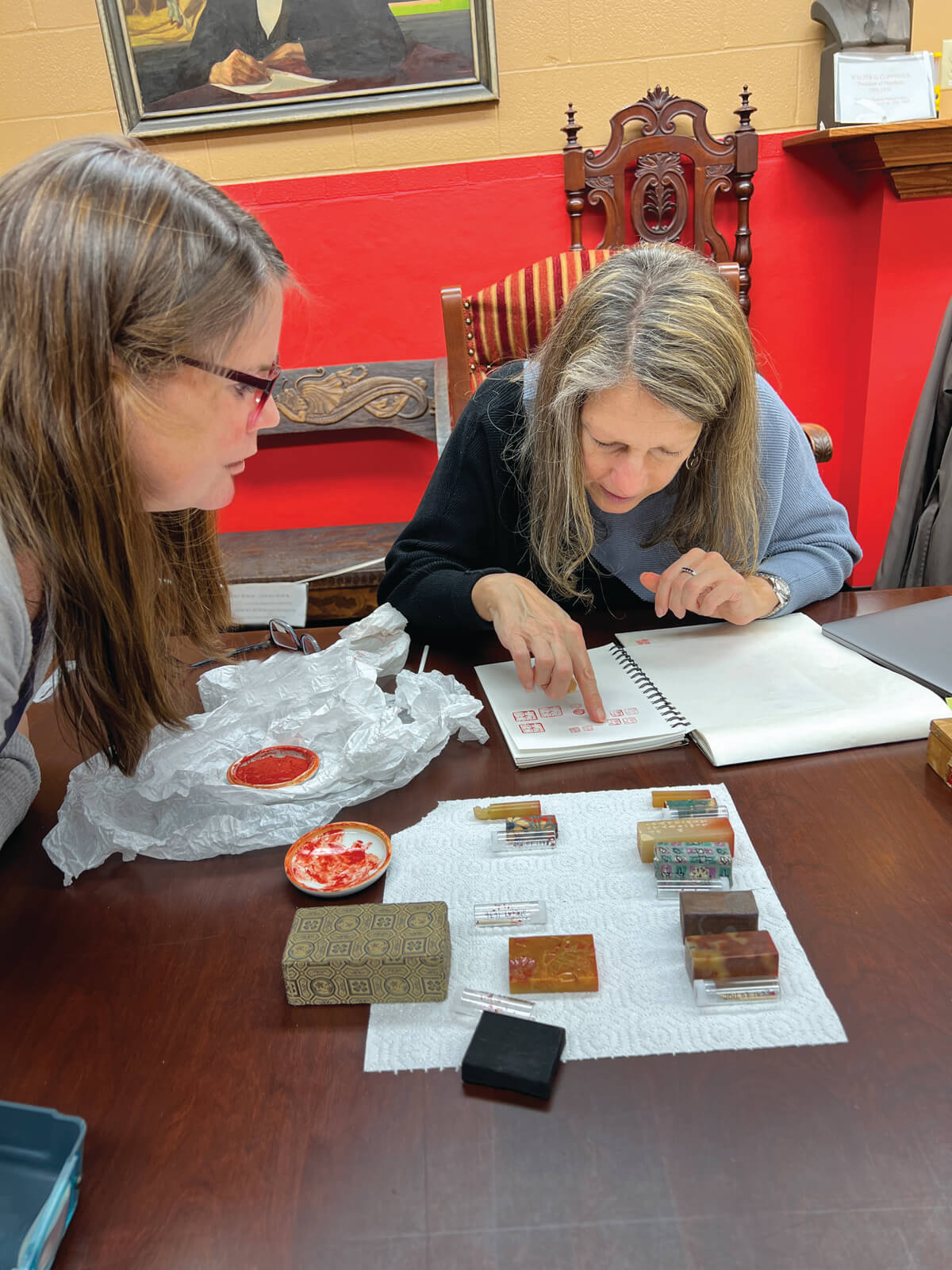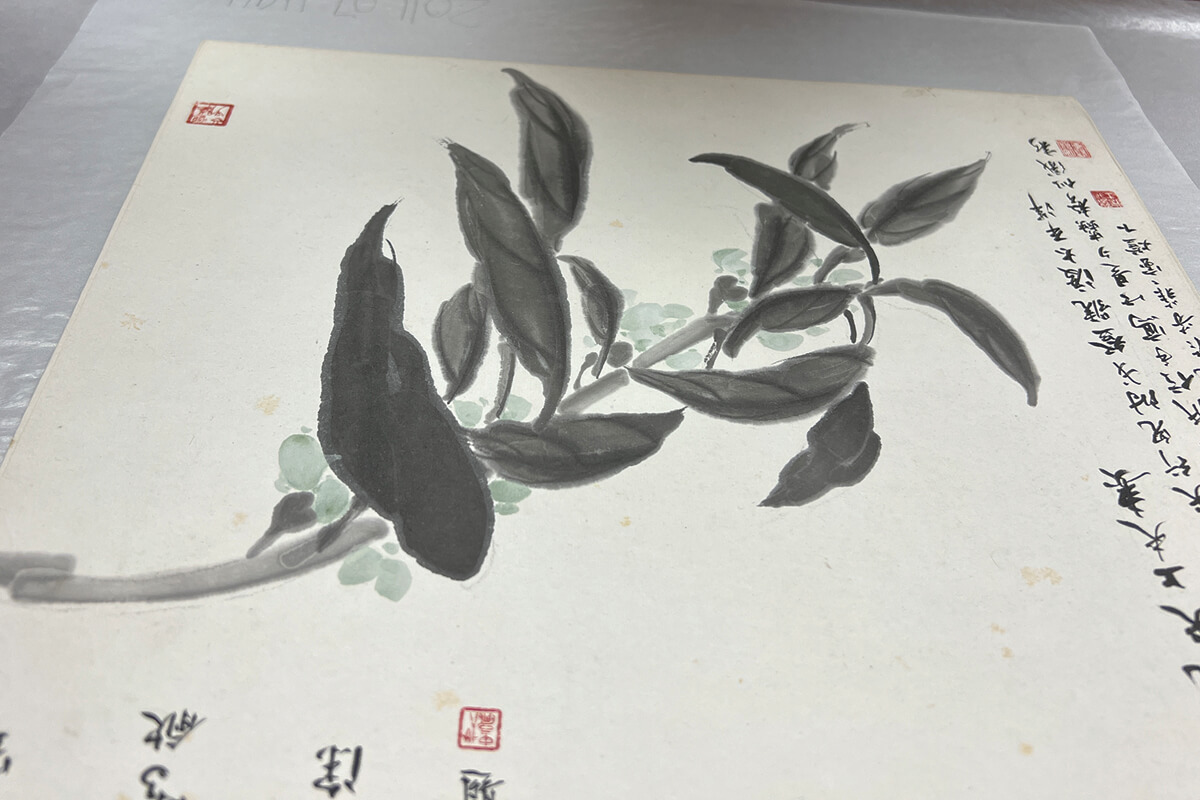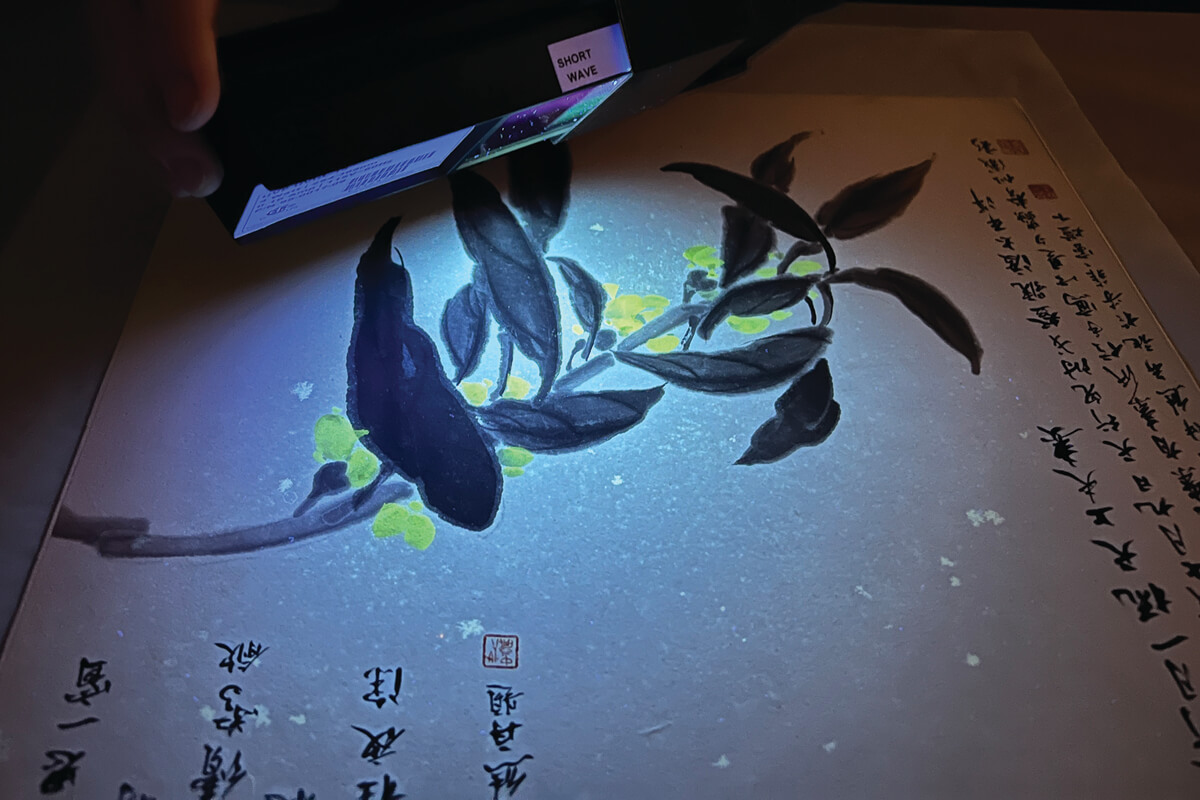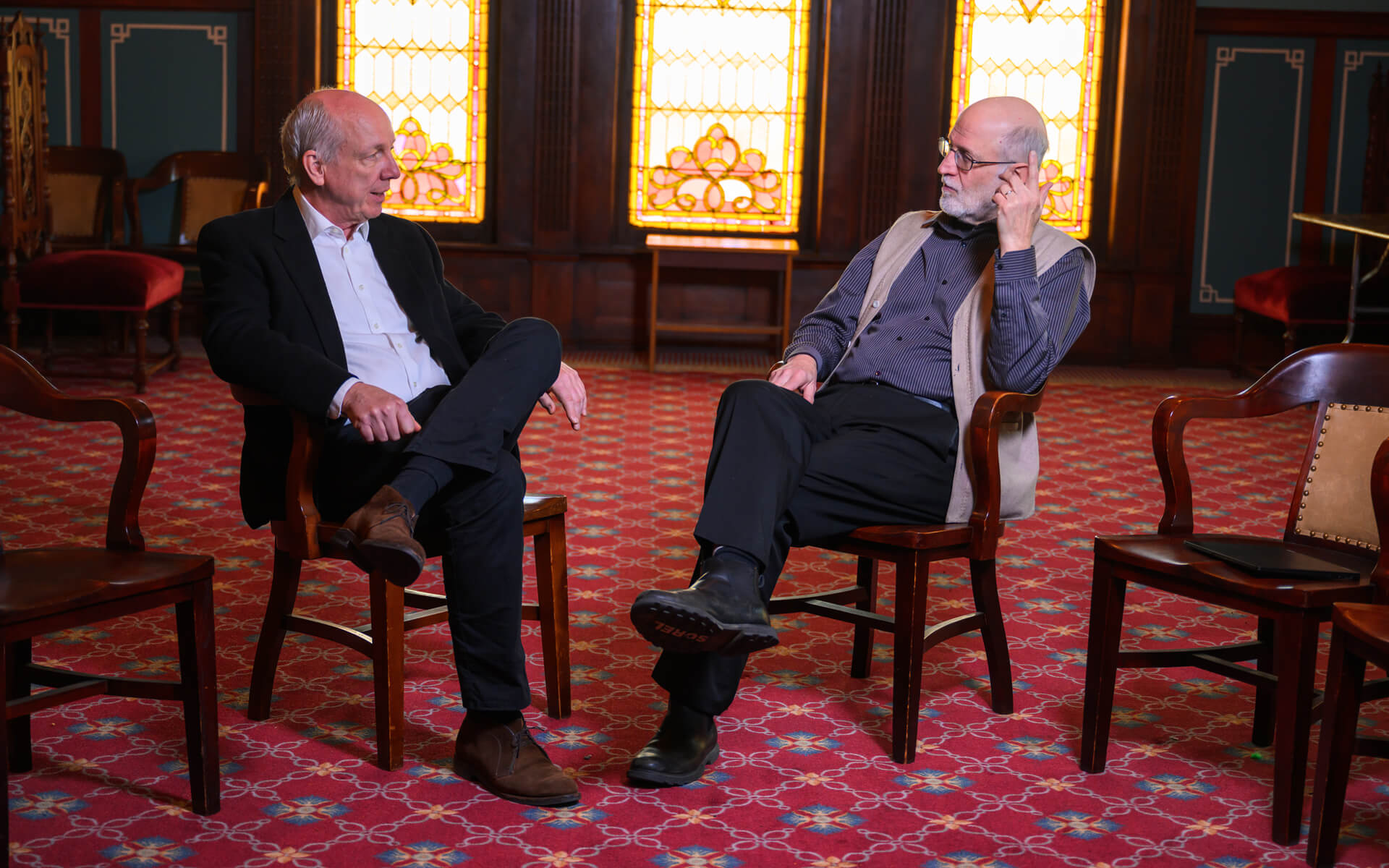Faculty Pairings Amplify The Power Of Collaboration
What happens when you make a smart pairing? At Otterbein, faculty collaborations are the norm but the outcomes these partnerships produce are anything but. From Integrative Studies collaborations, which bring seemingly disparate subjects together into one class, to research projects with multidisciplinary applications — faculty partnerships are inspiring knowledge, discovery, social change, and exciting studentlearning experiences. Art secrets unlocked. Global wellness initiatives. Injury prevention for senior citizens. Happiness and the good life. These collaborations highlight the expertise, passion, and purpose that double when Otterbein professors join forces.
For Department of Art and Art History instructor Janice Glowski and Professor and Chair of Chemistry Joan Esson, collaboration is a passion. In their Integrative Studies classes together, and in Otterbein’s museums and galleries, they teach that “an art project is a chemistry experiment in disguise.”
Glowski, as Otterbein’s director of museums and galleries and art historian, brings her degrees in Asian art history, comparative religious studies, and chemistry to the collaboration while Esson’s research and teaching focus includes technical art analysis and applications in environmental and clinical chemistry.
“Soon after I arrived on campus in 2014, I approached the Chemistry Department and talked about collaboration,” Glowski said. “Joan was the quickest to respond and we began a project looking at African masks in the Otterbein collection. My students recorded from where the masks originated, who used them, and the context in which they were used. Joan’s chemistry students took samples and used light fluorescence to discover what substances were found on the masks.”
The early collaboration previewed what the two departments could achieve together.
One such collaboration currently can be found in Otterbein’s Frank Museum, where art and chemistry students are working together on the C.Y. Woo Chinese painting art collection. A $98,000 Henry Luce Foundation grant procured by Glowski helps orchestrate student collaboration.

L to R: Professor and Department Chair Joan Esson + Instructor Janice Glowski making seal impressions using C.Y. Woo’s original paste.
L to R: Professor and Department Chair Joan Esson + Instructor Janice Glowski making seal impressions using C.Y. Woo’s original paste.

C.Y. Woo artwork from Otterbein’s collection.

Artwork with light fluorescence.
Top: C.Y. Woo artwork from Otterbein’s collection. Bottom: Artwork with light fluorescence.
Glowski has earned National Endowment for the Arts and Ohio Arts Council grants in support of her efforts. She has managed projects supported by the Mellon and Kress foundations and the National Endowment for the Humanities, and has curated more than 20 exhibitions.
Esson actively involves undergraduate students in her work, is the co-principal investigator on the National Science Foundation (NSF)-funded Cardinal Scholars Program and is the co-lead on the Choose Ohio First Cardinal STEMM Scholars Program. She also enjoys her faculty-led study abroad course to Italy to study preservation and restoration of art.
“In Milan we visit Castello Sforzesco built in the 15th century, where Napoleon’s troops later plastered over art by Da Vinci,” Esson said. “We observe the restoration work, then go see The Last Supper in town. It’s amazing.”
Another collaborative partnership involves extending Otterbein’s community to rural Ugandan communities. Since 2016, professors Diane Ross in Education and Heidi Ballard in Sociology, Criminology, and Social Justice have collaborated in communities and remote rural Ugandan schools to implement Menstrual Hygiene Management (MHM) and Sexual Reproductive Health Education (SRHE).
Ross has been traveling to Uganda since 2009 supported by her non-profit organization — Forum For Youth Advocacy (FOYA) Uganda — to engage more than 75 students and community members to improve literacy, education, health and wellness, gender equity, and community engagement in rural Uganda. This work led to building libraries in multiple communities.
“An exciting feature of this work is that the projects support sustainable development as they align with several of the United Nations Sustainable Development Goals,” Ballard said.
Ross also was awarded a three-year Fulbright research grant to work with young adolescent development and teacher preparation. Ballard joined in 2016 to bring a global health perspective to the team. With partial funding from internal Otterbein grant awards, Ballard’s global health and sociological perspective helped to develop tools to measure the efficacy of the MHM/SRHE projects.
Ross and Ballard’s work incorporates participatory action research. In this methodology, community partnerships are developed to empower the local community members to create positive social change.
“We try to facilitate service-learning opportunities to empower American students to become global citizens,” Ross said.
In 2018, Ross and Ballard expanded their work from West Nile and Eastern Uganda to the Rwenzori Mountain region. They developed a partnership with an indigenous Bakonzo community who requested collaboration in establishing a community library, MHM/SRHE in their rural schools, and video recording of tribal elders’ climate change stories. Ballard earned the Otterbein High Impact Grant in 2022 to support the work along with FOYA funding.
“We envision a Uganda where youth are empowered to create and extend their skills and talents to build a strong future. We also hope we can contribute to an America where people value other cultures and ways of being,” Ross writes.
Professor Heidi Ballard (top far left) + Professor Diane Ross (second from top right) in Uganda.
Faculty partnerships are inspiring knowledge, discovery, social change, and exciting student learning experiences.
Assistant Professor of Engineering Elena Caruthers and Assistant Professor of Health and Sport Sciences Ashley Simons are using Otterbein’s Biomechanics Institute, created by the two departments, to study human movement. The lab is equipped with motion capture cameras and specialized software that allows Caruthers and Simons to record and analyze how people move.
Their latest work uses the lab’s camera system to focus on factors related to senior citizens’ risk of falls. Students are identifying best practices in senior citizens’ activities of daily living, including gait, rising from a chair, and stair climbing.
“We’re hoping to gather data to discover how people’s confidence levels affect their normal activities of daily living,” Caruthers said. “We have engineering and health science students working on the study, and we’re collaborating with the Lifelong Learning Community for study participants.”
L to R: Assistant Professor Ashley Simons + Assistant Professor Elena Caruthers.
L to R: Assistant Professor Ashley Simons + Assistant Professor Elena Caruthers.
Caruthers has had a passion for biomechanics ever since she was a dancer growing up but needed expertise on the clinical side. Simons is a doctorate-level physical therapist but realized she needed the biomechanical side. The collaboration was a natural fit.
The lab’s 10-camera Vicon Nexus system gives Caruthers and Simons the ability to study movement in three dimensions with great accuracy and precision. Once reflective markers are placed on various anatomical landmarks of the subject, the cameras track and recreate the subject’s three-dimensional movement. This data can then be further analyzed on a biomechanical level by examining variables like joint angles, velocities, and accelerations throughout the entire motion.
In other applications, Otterbein athletes use the lab to study, for example, their baseball pitching motions, and pinpoint specific biomechanical patterns that could be worked on to improve their delivery. But Caruthers and Simons are taking the technology to a different generation.
“By allowing us to evaluate body movement in senior citizens — to see how their joints are moving, how they use space, their velocity of movement,” Simons said, “we can correlate what we see in the physical world with the biomechanical measures in the data and perhaps help improve their movement during daily living activities to reduce the risk of falls.”
Caruthers and Simons hope to present their findings at conferences and in research journals.
Students are identifying best practices in senior citizens’ activities of daily living, including gait, rising from a chair, and stair climbing.
English Professor Jeremy Smith realized a few years ago his teaching and research interest in comparative literature would pair well with Associate Professor of History Richard Yntema’s focus on European economic and social histor y. Smith approached Yntema to teach an Integrative Studies course together, and that’s how INST 2204: Happiness and the Good Life was born.
In their course, Smith and Yntema lead students to discover how Western societies have defined “the good life” and the critical social challenges each society faced. They examine beliefs, culture, and conflicts over four eras: classical Athens, the Middle Ages and Renaissance, the revolutions of the 18th and 19th centuries, and post-World War II Europe.

L to R: Associate Professor Richard Yntema + Professor Jeremy Smith.
“ Raising questions with students about concepts such as virtue and justice provides them with more of an openness to the past by looking at it in a multidimensional way.”
– Richard Yntema
“We have a lot of common interests,” Smith said. “I always thought it would be a true integrative course to teach the great works of Western literature in tandem with Western civilization concepts. That’s what we do.”
Smith and Yntema use the texts of classic literature and history to examine ancient concepts and compare them to contemporary topics. The class integrates the study of social, political, and economic history with the close reading of works by Sophocles, Dante, Mars, and Camus.
“Raising questions with students about concepts such as virtue and justice provides them with more of an openness to the past by looking at it in a multidimensional way,” Yntema said. “Examining the past and relating it to the present highlights juxtapositions and inequalities students may not have realized before or allows them to see current issues in new ways.”
Smith has pursued his research interests in religion, philosophy, and literature throughout his career. He is the author of The Staircase of a Patron, a book chronicling the United Brethren in Christ’s presence in Sierra Leone, with a special focus on the missionary work of Otterbein graduate Lloyd Mignerey ’1917.
Yntema’s research focuses on European economic and social history. He explores the development of capitalism in Holland before 1800 in a global framework. In 2010, he was a Fulbright Scholar at the University of Utrecht. In his courses he explores the Renaissance and Reformation, revolutions in early modern Europe, and global capitalism, among other eras.
The collaboration contributes a humanistic capstone to Otterbein’s Integrative Studies program and is a prime example of how Otterbein’s faculty community maintains Otterbein’s commitment to the contemporary significance of a liberal arts education.
